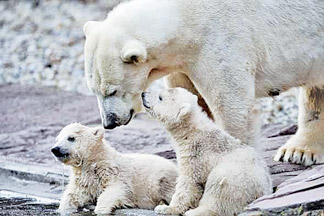In Focus
Polar bear cubs dying due to long swims
Polar bear cubs forced to swim long distances with their mothers as
their icy Arctic habitat melts appear to have a higher mortality rate
than cubs that didn't have to swim as far, a new study reports.Polar
bears hunt, feed and give birth on ice or on land, and are not naturally
aquatic creatures. Previous reports have noted individual animals
swimming hundreds of miles to reach ice platforms or land, but this is
one of the first to show these swims pose a greater risk to young polar
bear .
"Climate change is pulling the sea ice out from under polar bears'
feet, forcing some to swim longer distances to find food and habitat,"
said Geoff York of World Wildlife Fund, a co-author of the study.York
said this was the first time these long swims had been quantitatively
measured, filling a gap in the historical background on this iconic
Arctic species.
 To
gather data, researchers used satellites and tracked 68 polar bear
females equipped with GPS collars over six years, from 2004 through
2009, to find occasions when these bears swam more than 30 miles at a
time.There were 50 long-distance swims over those six years, involving
20 polar bears, ranging in distance up to 426 miles and in duration up
to 12.7 days, according to the scientific paper. To
gather data, researchers used satellites and tracked 68 polar bear
females equipped with GPS collars over six years, from 2004 through
2009, to find occasions when these bears swam more than 30 miles at a
time.There were 50 long-distance swims over those six years, involving
20 polar bears, ranging in distance up to 426 miles and in duration up
to 12.7 days, according to the scientific paper.
At the time the collars were put on, 11 of the polar bears that swam
long distances had young cubs; five of those polar bear mothers lost
their cubs during the swim, representing a 45 per cent mortality rate,
the study found.
Cubs that didn't have to swim long distances with their mothers had
an 18 percent mortality rate, the study said.
"They're a lot like us," York said. "They can't close off their nasal
passages in rough waters. So for old bears or young bears alike, if
they're out in open water and a storm hits, they're going to have a
tough time surviving."
Two factors make it even harder for polar bear cubs to weather long
periods in Arctic waters, said Steve Amstrup, a former scientist at the
U.S. Geological Survey and now chief scientist at Polar Bears
International, a conservation group.
"Young bears don't have very much fat and therefore they aren't very
well insulated and cannot cope with being in cold water for very long,"
Amstrup said.Because they are leaner than their parents, Amstrup said,
"they probably aren't as buoyant (as adult polar bears) so in rough
water they'll have more difficulty keeping their heads above water.
The Bush administration listed polar bears as threatened under the
Endangered Species Act because of the decrease in their Arctic ice
habitat. That decision survived a legal challenge last month, and this
month, Canada listed polar bears as a species at risk.The Arctic is
warming faster than lower latitudes due to the accumulation of
greenhouse gases in the atmosphere, and the melting of sea ice in summer
accelerates the warming effect. Arctic sea ice extent - the area covered
by sea ice , in June was the second lowest in the satellite record since
1979, according to the National Snow and Ice Data Center.
Courtesy: Reuters

Earth
1. How are whirlpools formed?
2. Name the world's highest waterfall in Venezuela which plunges down
3,300 feet?
3. What are igneous rocks?
4. Tornadoes are destructive and violent whirl winds whose force is
concentrated into a smaller area than a hurricane.True/False?
5. Who propounded the theory of the Continental Drift?
Animals and plants
1. How do we define an amphibian?
2. Spiders spin their webs from a very fine silk which is extracted
out from tiny nodules at the back of their abdomen. What are these
nodules called?
3. The chlorophyll present in the leaves harness the energy of the
Sun to make three things. Name them.
4. At which part of body are the eyes of a starfish located ?
5. How many stomachs does the camel have?
Science and technology
1. How is nuclear energy produced?
2. An electromagnet can only produce magnetism when an electrical
current passes through it. True/ False ?
3. One of the most important developments in biology has been the
cracking of the 'genetic code'.What discovery made this possible?
4. The earliest bicycle was made by Baron van Drais of Germany and he
named this bicycle as Draisine.True/ False ?
5. How is coal formed ?
Answers
Earth
1. Whirlpools are formed when opposite currents meet; they cause the
water to spin round and round very rapidly.The most famous whirlpool is
the Mael storm which appears between islands off the coast of Norway.
2. The world's highest waterfall is Venezuela's Angel Falls.
3. Igneous rocks are formed below and above the Earth's surface when
the molten lava which flows from volcanic eruptions cool down. Generally
these rocks are hard and granular.
4. True.
5.The theory of the Continental Drift was propounded by a German
meteorologist named Alfred Wegener (1880-1930).
Animals and plants
1. An amphibian is an animal which can survive on land as well as in
water. There are about 4,400 species of amphibians living on Planet
Earth.
2. Spinnerets.
3. The chlorophyll present in the leaves harness the energy of the
Sun to make sugar, starch and cellulose.
4. The eyes of a starfish are located at the tip of its arms.
5.The camel has three stomachs.It uses the first to store food while
it is grazing. In the second stomach there are the digestive juices and
in the third the chewed cud is digested. In the walls of the first two
stomachs there are pockets for storing water Muscles keep these pockects
closed when they are full.
Science and technology
1. Nuclear energy is produced when there is a change in the nucleus
of an atom of a radioactive element like Uranium or Plutonium.
2. True.
3. The discovery of the structure of DNA ( Deoxyribosenucleic acid )
molecule.
4. True.
5. It is formed by the compressed remains of trees,plants,ferns and
other primitive animals that lived in bogs about 300 million years ago. |

